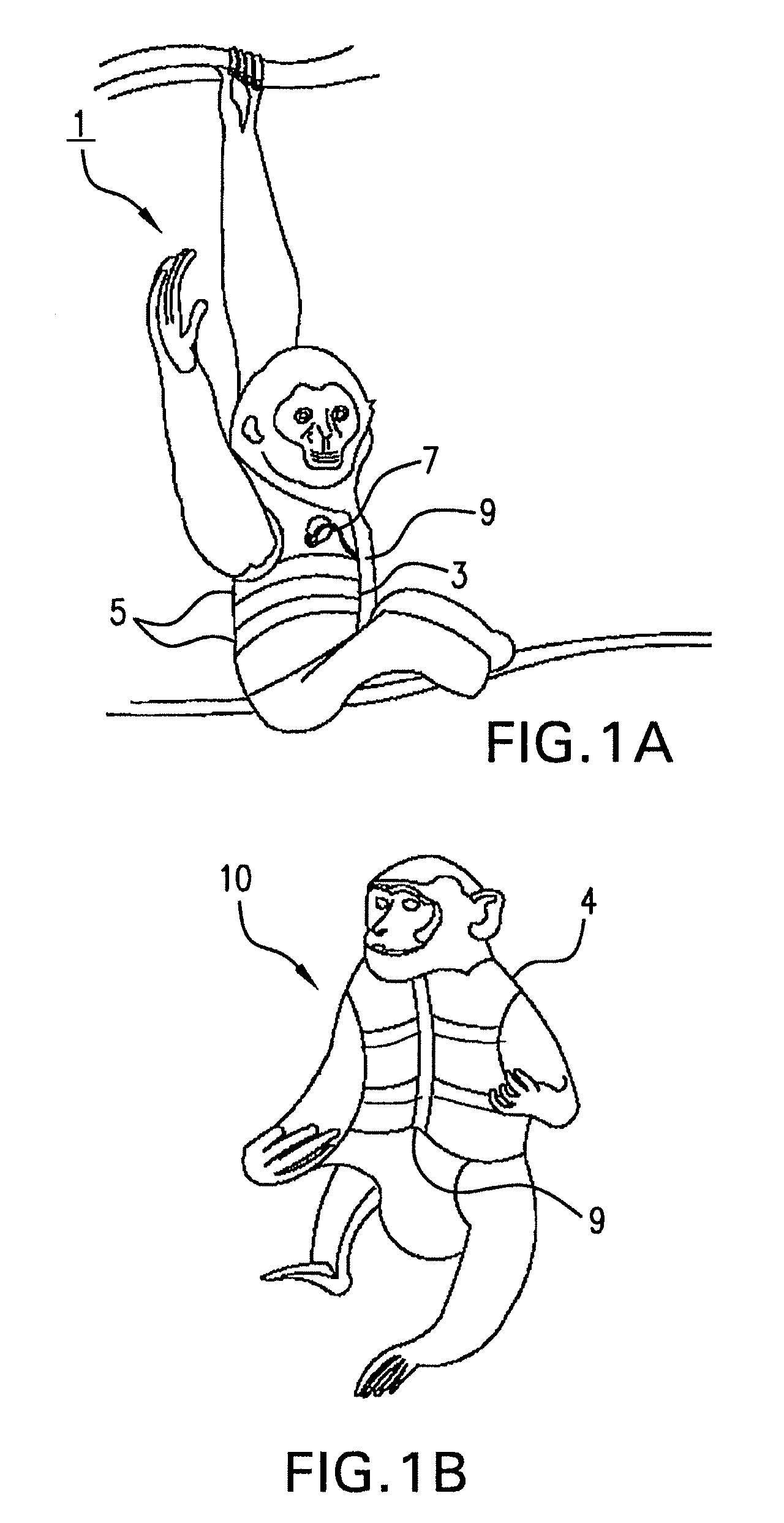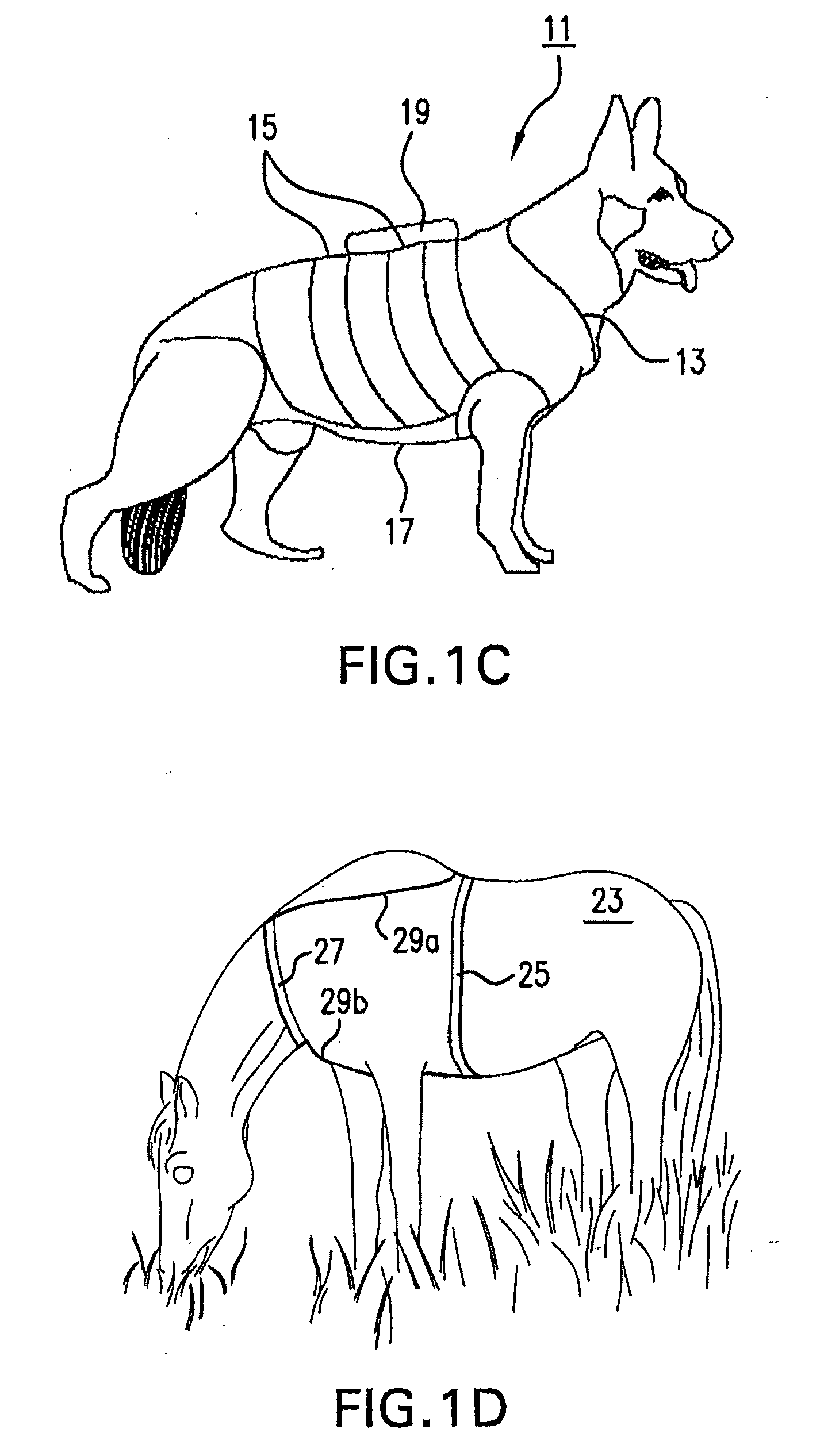Systems and methods for non-invasive physiological monitoring of non-human animals
- Summary
- Abstract
- Description
- Claims
- Application Information
AI Technical Summary
Benefits of technology
Problems solved by technology
Method used
Image
Examples
example 1
[0062]FIGS. 3A and 3B illustrate processing of monitoring data from a monkey obtained with the monitoring garment of FIG. 3C, which has substantially similar features to the monitoring garment embodiment of FIGS. 2A-E. The monitoring garment of FIG. 3C also incorporates the electrical circuitry and configurations that are described in more detail in U.S. Pat. No. 6,551,252, which is expressly incorporated herein for all purposes in its entirety thereto.
[0063]FIG. 3A illustrates one minute of processed respiratory and accelerometer data along with an ECG signal also obtained using the monitoring garment. Band 85 illustrates processed accelerometer data, and shows that during this minute of data the monkey engaged in little activity and made no posture changes. Band 81 illustrates the monkey's tidal volume during this period of substantially little activity, and shows that the monkey was breathing at a regular rate with regular tidal volumes. Band 83 illustrates ECG data and shows a r...
example 2
[0065]FIGS. 4A and 4B illustrate processing of monitoring data from a beagle obtained with a monitoring garment of FIG. 4C, which has substantially similar features to the monitoring garment adapted to fit a monkey shown in FIG. 3C. FIG. 4A illustrates five minutes of processed data including tidal volume (Vt), ECG, heart rate (HR), and accelerometer (ACC) data, and an index of respiratory sinus arrhythmia (RSA). By measuring the combination of respiratory and ECG signals in an unrestrained animal, clear identification and evaluation of periods of ‘pure’ ECG, i.e., those unaffected by the respiratory cycle, can be made. Utilization of these stable periods for the analysis of the timing components of the ECG signal (e.g., Q-T interval) provides investigators an opportunity for greater precision thereof than is currently possible.
[0066]Specifically, during periods of central apnea (cross-hatched areas where the tidal volume trace is substantially flat), which are common in sleeping ca...
example 3
[0067]Continuous monitoring of non-human animals primates (NHP), enables identification of behavioral and activity patterns that indicate when such an animal may be agitated or experiencing stress. For example, such patterns may indicate that an animal, which was once previously thriving in the environment with other animals, is beginning to manifest negative behavior that could result in their removal from a research colony. This inappropriate behavior is broadly termed ‘stereotypical’ behavior, and ranges from repetitive movements to obsessive behaviors, and at the extreme, severe self-injurious behavior. Animals who display stereotypical behaviors are not effective for research and are typically removed from the cohort of available animals. Moreover, if they don't positively respond to environmental and stimuli changes, they cannot be further used for research in the future.
[0068]Physiological data collected with the monitoring garment of FIG. 3C can identify abnormal movement pa...
PUM
 Login to View More
Login to View More Abstract
Description
Claims
Application Information
 Login to View More
Login to View More - R&D
- Intellectual Property
- Life Sciences
- Materials
- Tech Scout
- Unparalleled Data Quality
- Higher Quality Content
- 60% Fewer Hallucinations
Browse by: Latest US Patents, China's latest patents, Technical Efficacy Thesaurus, Application Domain, Technology Topic, Popular Technical Reports.
© 2025 PatSnap. All rights reserved.Legal|Privacy policy|Modern Slavery Act Transparency Statement|Sitemap|About US| Contact US: help@patsnap.com



